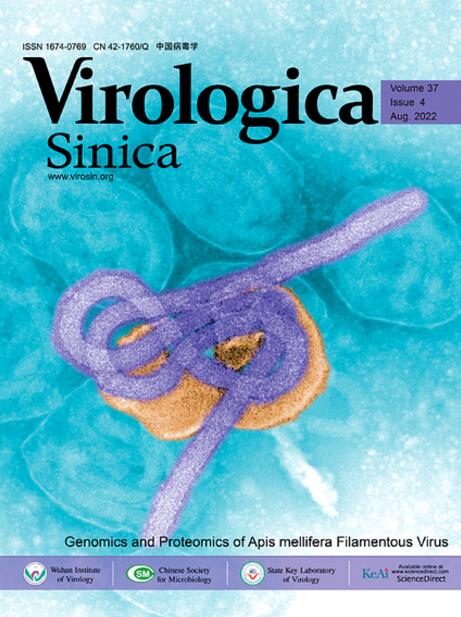白斑综合征病毒通过 wsv406 靶向 BiP 来调节未折叠蛋白反应,从而促进病毒复制。
IF 4
3区 医学
Q1 Medicine
引用次数: 0
摘要
疾病的爆发往往与环境压力有关,环境压力会导致内质网(ER)应激,进而引发未折叠蛋白反应(UPR)。白斑综合征病毒(WSSV)是对虾养殖中最严重的病原体,其复制已被证明依赖于 UPR 信号通路,但具体机制仍不甚明了。在这项研究中,我们发现 WSSV 通过病毒蛋白 wsv406 劫持 UPR 通路来增强其复制能力。我们的分析发现,wsv406 在受感染对虾的血细胞和鳃中明显上调。质谱分析发现,wsv406 与凡纳滨对虾体内的免疫球蛋白重链结合蛋白(BiP)有特异性相互作用。进一步研究发现,wsv406 与 LvBiP 的多个结构域结合,抑制了其 ATPase 活性,但没有破坏其与 UPR 应激受体的结合。抑制 wsv406 或 LvBiP 可减少 WSSV 复制,提高对虾存活率。此外,在 WSSV 感染期间,当 wsv406 被沉默时,eIF2α 的磷酸化和 ATF6 的核转运减少,这证明了 wsv406 对 PRKR-like ER kinase (PERK) -eukaryotic translation initiation factor 2α (eIF2α) 和 activating transcription factor 6 (ATF6) 途径的激活。这种激活促进了 WSSV 基因的转录,促进了病毒的复制。总之,这些发现揭示了 wsv406 通过靶向 LvBiP 操纵宿主 UPR,从而通过 PERK-eIF2α 和 ATF6 途径增强 WSSV 复制。这些关于 WSSV 与宿主细胞机制之间相互作用的见解为开发治疗干预措施以控制对虾养殖中 WSSV 的爆发提供了潜在靶点。本文章由计算机程序翻译,如有差异,请以英文原文为准。
Modulation of the unfolded protein response by white spot syndrome virus via wsv406 targeting BiP to facilitate viral replication
Outbreaks of diseases are often linked to environmental stress, which can lead to endoplasmic reticulum (ER) stress and subsequently trigger the unfolded protein response (UPR). The replication of the white spot syndrome virus (WSSV), the most serious pathogen in shrimp aquaculture, has been shown to rely on the UPR signaling pathway, although the detailed mechanisms remain poorly understood. In this study, we discovered that WSSV enhances its replication by hijacking the UPR pathway via the viral protein wsv406. Our analysis revealed a significant upregulation of wsv406 in the hemocytes and gills of infected shrimp. Mass spectrometry analysis identified that wsv406 interacts specifically with the immunoglobulin heavy-chain-binding protein (BiP) in shrimp Litopenaeus vannamei. Further examination revealed that wsv406 binds to multiple domains of LvBiP, inhibiting its ATPase activity without disrupting its binding to UPR stress receptors. Silencing either wsv406 or LvBiP resulted in a reduction in WSSV replication and improved shrimp survival rates. Further, wsv406 activation of the PRKR-like ER kinase (PERK)-eukaryotic translation initiation factor 2α (eIF2α) and activating transcription factor 6 (ATF6) pathways was demonstrated by a decrease in the phosphorylation of eIF2α and the nuclear translocation of ATF6 when wsv406 was silenced during WSSV infection. This activation facilitated the transcription of WSSV genes, promoting viral replication. In summary, these findings reveal that wsv406 manipulates the host UPR by targeting LvBiP, thereby enhancing WSSV replication through the PERK-eIF2α and ATF6 pathways. These insights into the interaction between WSSV and host cellular machinery offer potential targets for developing therapeutic interventions to control WSSV outbreaks in shrimp aquaculture.
求助全文
通过发布文献求助,成功后即可免费获取论文全文。
去求助
来源期刊

Virologica Sinica
Biochemistry, Genetics and Molecular Biology-Molecular Medicine
CiteScore
7.70
自引率
1.80%
发文量
3149
期刊介绍:
Virologica Sinica is an international journal which aims at presenting the cutting-edge research on viruses all over the world. The journal publishes peer-reviewed original research articles, reviews, and letters to the editor, to encompass the latest developments in all branches of virology, including research on animal, plant and microbe viruses. The journal welcomes articles on virus discovery and characterization, viral epidemiology, viral pathogenesis, virus-host interaction, vaccine development, antiviral agents and therapies, and virus related bio-techniques. Virologica Sinica, the official journal of Chinese Society for Microbiology, will serve as a platform for the communication and exchange of academic information and ideas in an international context.
Electronic ISSN: 1995-820X; Print ISSN: 1674-0769
 求助内容:
求助内容: 应助结果提醒方式:
应助结果提醒方式:


